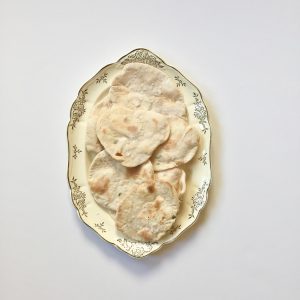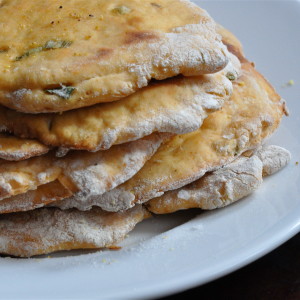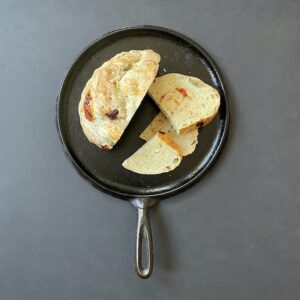Middle Eastern Yogurt Bread
 Commercial bread is so good here in the Bay Area that nobody needs to bake their own. But after picking up Diana Henry’s A Change Of Appetite, I all but ran into the kitchen.
Commercial bread is so good here in the Bay Area that nobody needs to bake their own. But after picking up Diana Henry’s A Change Of Appetite, I all but ran into the kitchen.
The Irish born Henry lives and works in London, where she’s well-known. According to her website, before attending cookery school and beginning to write about food, Henry studied English Literature at Oxford. This makes Henry a quintessentially British food writer, for like Jane Grigson and Elizabeth David before her, she brings a classical education into the kitchen.
So, this bread. Calling for whole wheat flour, bread flour, and yogurt, it’s a departure from my usual fare. In addition to attacking the joints, Ehlers-Danlos Syndrome wracks the digestion. Whole wheat is a particular offender. In addition to helping the gut, yogurt mitigates the gnawing-on-a-beige-comforter quality some wheat breads have. Instead, you get a crisp crust, soft crumb, and good keeping qualities.
At this time of year there’s no good reason not to add roasted tomatoes to the dough:

And scallions:

Well, one reason: you don’t want to. This bread is forgiving. It’s delicious all by itself.
Before launching into recipes and instructions, a few encouraging words about bread baking.
People fear bread baking. I suspect this is actually fear of yeast. And just behind fear of yeast lurks fear of failure.
Nobody enjoys failure, in the kitchen or out. But we aren’t performing neurosurgery here. Most kitchen errors result in edible food; worst case, you’ll have to throw something out. While upsetting from a waste standpoint, it’s not the end the of the world. Very honestly, we weren’t feeding Africa with that failed loaf.
Food media–magazines, television shows, blogs like this one–are full of beautiful, scary food that can make us feel pretty insecure about our abilities.
Here’s the very first loaf of Middle Eastern Yogurt bread I baked. Not too pretty. But it tasted just fine.

Perfectionism is the enemy of trying new things. Give yourself permission to be less than perfect. To make mistakes.
Yogurt Bread with Roasted Tomatoes And Scallions
Adapted from Diana Henry’s Middle Eastern Yogurt Bread
2 medium heirloom tomatoes, preferably organic
olive oil
1-2 scallions, white and pale green parts, chopped
1 1/3 cups whole wheat flour
1 cup+3 tablespoons bread flour or All-purpose flour (see note)
1/2 teaspoon table salt
3 1/2 tablespoons water
3/4 teaspoon sugar
1 teaspoon yeast
2/3 cup full-fat yogurt
3 tablespoons olive oil + extra for oiling loaf and plastic wrap
1/2 cup water
flour for dusting countertop
To roast the tomatoes:
Preheat the oven to 200 degrees Fahrenheit.
Slice tomatoes and lay them on a baking sheet. Drizzle olive oil over. Bake for two hours, or until dried to your taste.
Slice scallions. Put aside.
While the tomatoes roast, prepare the bread.
To Bake The Bread:
In your largest bowl, mix the flours and salt.
Measure 3 1/2 tablespoons water into a small bowl and microwave 15 seconds. The water should be warm but not burning hot. If too hot to put a finger in, allow to cool a few moments, then stir in sugar and yeast. Set aside for about five minutes.
Yeast is ready when it looks frothy, like the head of a freshly poured beer.
Stir yeast, yogurt, and olive oil into the flour.
Have the 1/2 cup of water beside the bowl.
At this point you can begin stirring with a wooden spoon or dig in with your dominant hand. Stir in one direction, getting the flours to integrate with the wet ingredients. If the flours begin clumping at the bottom of the bowl, add a little water and mush with your hand; think of making mudpies. Begin folding the dough over itself. It should begin cohering. This is the part people don’t tell you: when yeast is alive and gluten is forming, the bread dough begins feeling like dough.
Flour still clumping at the bottom? Add more water until the ingredients all find each other. You may not need all the water. Or you may need a little more. This depends on the weather and your flour.
At this point, dust your countertop lightly with flour and dump out the dough. It’s time to knead.
You cannot overknead by hand. So stop worrying. Fold the dough in half, push it away from you, turn it, repeat. Keep doing this. Think of moving from your shoulders, not your wrists. You’ll feel the bread begin responding, becoming smoother, more elastic. If it’s been sticking to your countertop, or you, it will stop.
Knead from 5-10 minutes. If at any time the dough feels like it’s fighting you, like it’s getting heavy, stop for a few moments. Or if you just need to take a break, take one. Allow the gluten to relax.
Shape the dough into a ball, smooth it lightly with olive oil–don’t slather it–and place it in a bowl. Cover the bowl with plastic wrap that’s also gotten a bit of olive oil. Allow it to rise for 2 hours at room temperature, whereupon it will double in bulk.

When your 2 hours are up, take your tomatoes out of the oven and crank it up to 400 degrees F.
Now slice your tomatoes, which will be a messy operation. I do this in a pan, adding the scallions.

Now punch down your bread. It will deflate.
Have a baking pan ready.
Knead the bread a little in the bowl–just a couple turns. Add the tomatoes and scallions, and try to fold into the center of the loaf, smoothing the edges around, creating an oval. It will seem like a slippery mess, with tomato and scallion squelching out the sides.
Don’t be discouraged: it will come together in baking. Place the loaf seam-side down on the baking sheet, Cover it with the plastic wrap and allow it rest 45 minutes. It may look like it’s not doing much. Don’t worry.

After 45 minutes, remove the plastic wrap and place the loaf in the oven. Bake 30-35 minutes. Bread is done when loaf is browned and sounds hollow when thumped.
Note: I baked this with all-purpose flour and bread flours; both worked.

Eat with lots of butter, Kerrygold Irish for preference.
Sliced and well-wrapped, this bread freezes well.
Diana Henry, A Change Of Appetite: Mitchell Beazley Books 2014
Diana Henry’s website: http://dianahenry.co.uk/




